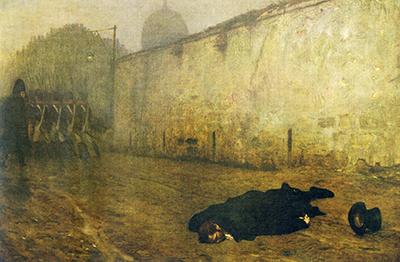The Execution of Marshal New by Jean-Leon Gerome is an oil on canvas painting with a Dimension of 7.8 x 12.4 cm. The contents of the image is an executed man lying face down on the ground, and the firing squad can be seen at a distance. There is a huge wall on the right side of the image with two inscriptions. One of the inscriptions is Vive I empreur meaning “long live the emperor’ and the word Vive alone. The holes made by the executioner’s bullets are also visible on the wall parallel to where the man is lying. A hat that could have fallen off during his execution lies next to the executed man showing either struggle or the impact of the execution.
The scene depicted in the image is a moment after the execution of the French marshal Michel Ney in December 1815. Ney was a heroic marshal in Napoleon’s army but pledged his allegiance to the Bourbon Monarchy when Napoleon was abdicated in 1814. Ney later re-joined Napoleon when he returned to France and was accused of plotting the return. For that reason, the Monarch charged him for treason. The execution was unique because he refused to be blindfolded and was also allowed to give soldiers the order to fire him.
Current Location of the Artwork
The painting is currently in the Graves Art Gallery in Sheffield, England. Some of the previous owners of the artwork after Lord Farringdon presented it in 1931 include Sheffield Galleries and Museums Trust.
Gerome’s Painting Style
Most of Gerome’s paintings showed the aftermath but not the incident. The art is similar to The Death of Caesar, which also had the same thematic and structural similarities. The victim is the main subject in both paintings and is placed in the foreground. The killers are also at a distance departing from the scene. The executioners also display the weapons used and the person who makes main subject in the execution is some steps behind the rest of the group. The painting was done with a naturalistic approach but was misunderstood when the art was shown in the Salon. Most Critics considered it an insult to the respected Marshal of France by drawing him lying on mud.
Who Inspired Gerome into Painting
Most of Gerome’s paintings exhibit a flawless use of colour and mastery in sketching similar to that of his teacher Paul Delaroche. The artist spent a lot of time with Delaroche and even visited Rome with him where he got inspired in Romanticism.




